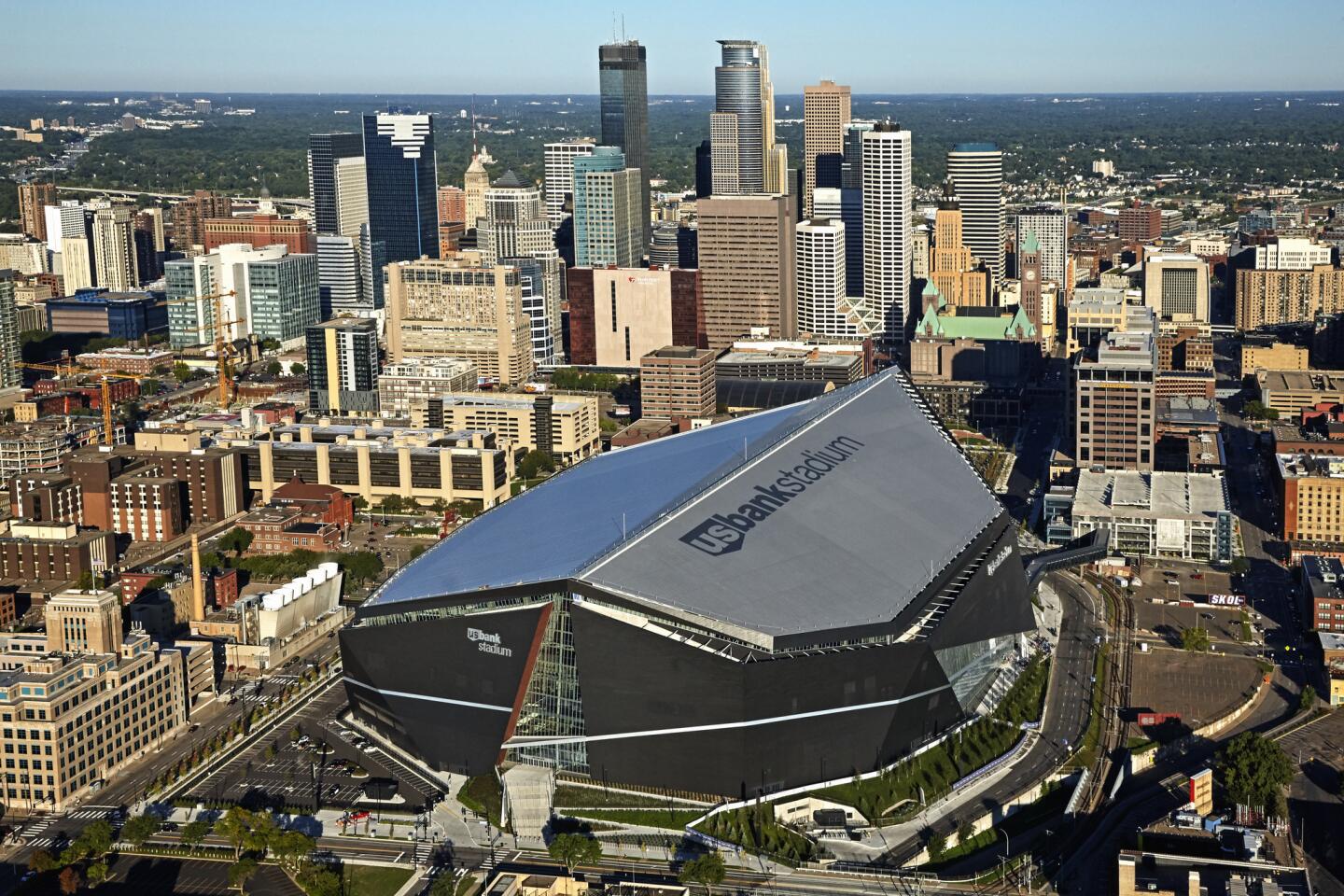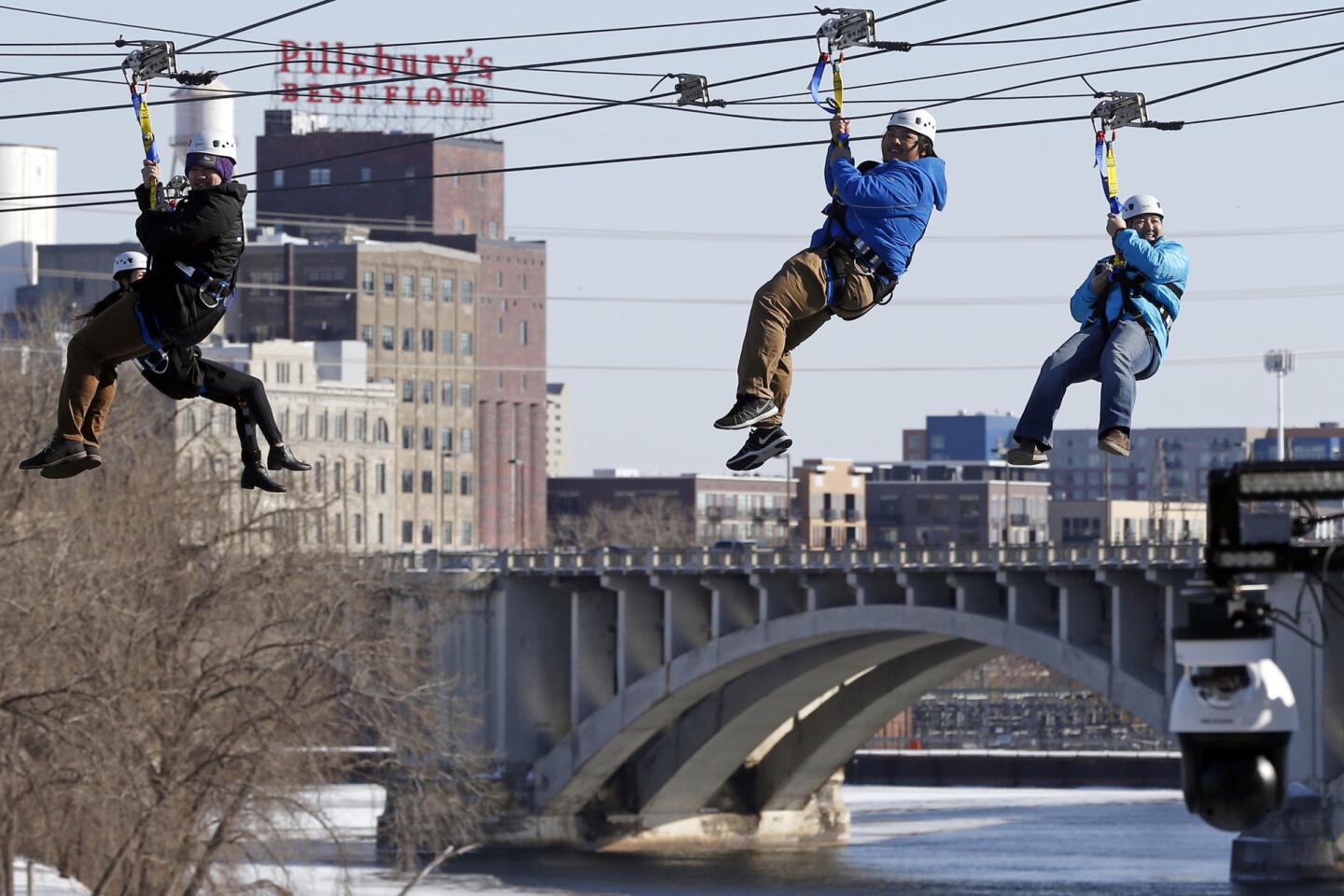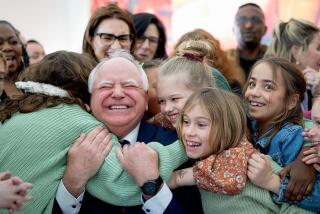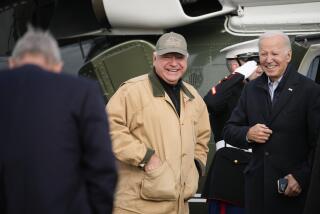The big game may be over, but youâll warm to Minneapolis. We promise.
Reporting from Minneapolis â Iâm writing this just before New Yearâs, and the morning sky is cloudless blue crystal, the fresh snow-white snow is sparkling like, well, snow, and itâs beautiful outside. It really is.
Itâs also 13 degrees below zero.
I swore I wouldnât write the old âguess what â itâs cold in Minnesotaâ story. I mean, doesnât everybody know that? Surely, theyâve at least heard the rumors.
I just brought in my shivering dogs from a one-block forced march, and the only thing I have to say to Super Bowl visitors from the Golden State is what weâve been telling outsiders since before statehood 160 years ago:
I hope you have warm clothes.
Here is where any decent Minnesota-in-winter story lays out all the stateâs wonderful attractions: world-class museums, an acclaimed symphony orchestra, a great university, lots of good live theater, trendy restaurants, Lake Superior, the Mall of America.
All good, all true, but note that with one exception, everything on that list is indoors. And none of it changes the fact that itâs still 13 below zero.
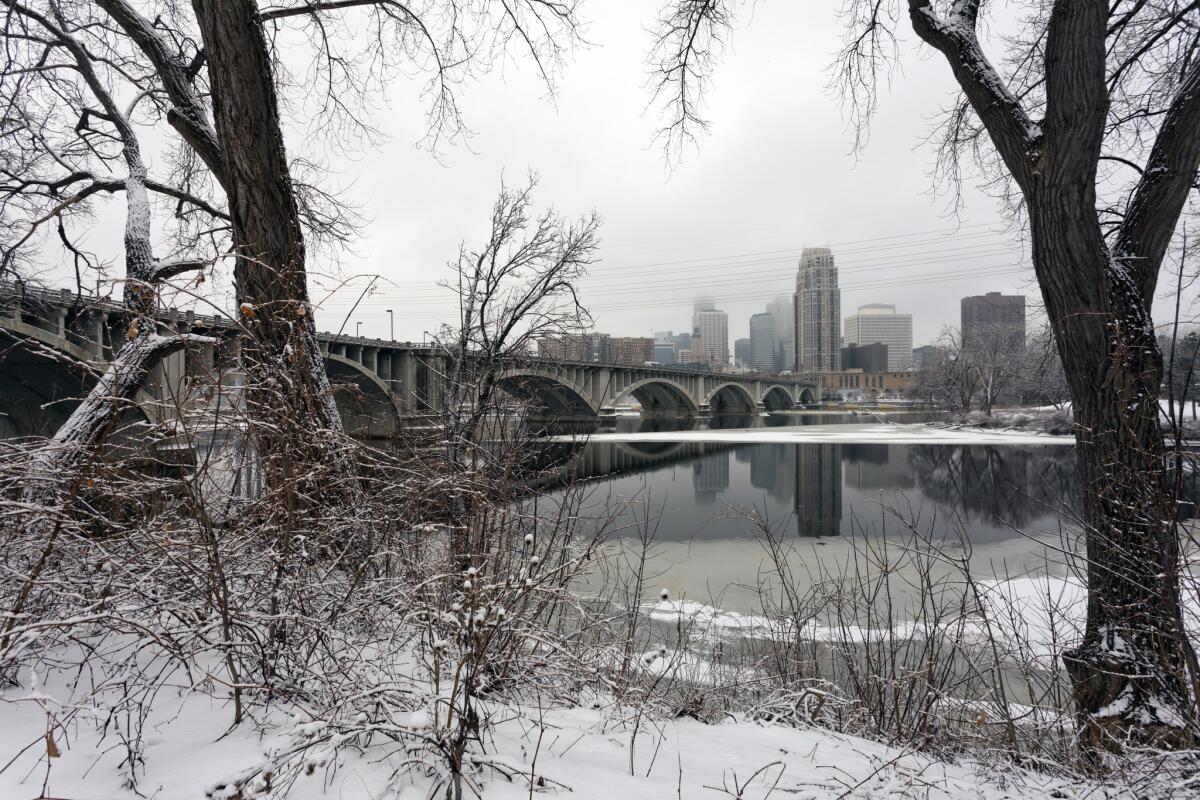
But such sustained low temps are good news. They mean downtown St. Paulâs 70-foot-tall Ice Palace will stay frozen, and so will the ice sculptures on Minneapolisâ Lake of the Isles as well as the snowmen and snowwomen on residentsâ lawns.
At least 100,000 guests are in town this weekend. Demand for rooms was so high that locals moved in with friends and relatives so they could rent their homes. Gridlock threatened. And one premier event â the Bold North Zip Line across the Mississippi and into downtown â sold all its 10,000 tickets in a matter of hours.
The Super Bowl isnât the only thing making the Twin Cities more crowded and complicated. The big game falls in the middle of St. Paulâs 17-day Winter Carnival, an annual celebration since 1886 with its own traditions, throngs of revelers and the Ice Palace.
The Super Bowlâs centerpiece, of course, is the shining 18-month-old U.S. Bank Stadium, set like a giant nonmelting ice crystal on the edge of downtown Minneapolis. It blends so well with the sky that birds keep trying to fly through it.
But the whole city has been primping ever since the NFLâs choice for the game was announced in May 2014, and it shows.
Minneapolis trivia
Beyond the glitter and hullabaloo, there are subtler things about Minneapolis and St. Paul that are worth sharing. Here are a dozen:
1. Any place name starting with âMin,â âMinne â or âMneâ has its root in the Dakota (Sioux) word for âwater.â
Hence Minnesota, usually translated as âland of sky-blue water,ââ Lake Minnetonka, âgreat waterâ in Dakota, and towns such as Minnetrista, Mineota and Minneapolis itself. That name combines âwaterâ in Dakota with the Greek word for âcityâ â a great example of early civic confidence.
2. Minnesotaâs premier historic site, Ft. Snelling â the first U.S. military post built west of the Mississippi â has a new name in time for its 200th birthday this year. It is now Ft. Snelling at Bdote.
That Dakota word connotes âconfluence,â which is what the fort guards. Its gray stone walls overlook the Minnesota River, which joins the Mississippi here.
3. Thereâs a sobering reason behind that name change: About 1,700 Native Americans were held in Ft. Snelling through a harsh winter after the U.S.-Dakota War of 1862. Many died. The Minnesota Historical Society, which manages the fort, changed the name to honor their heritage too.
4. Itâs impolite to point out that St. Paul was originally called Pigâs Eye. Especially while youâre in St. Paul.
The old name had little to do with pork and a lot to do with booze. It came from a disreputable settler of French descent, Pierre âPigâs Eyeâ Parrant, who sold whiskey in the early 1840s from a rough establishment at what would become downtown St. Paul.
5. We arenât all Scandinavians, although a lot of 19th century immigrants were. Hence lutefisk recipes at Christmastime â lutefisk jokes year round, for that matter â and blond people who occasionally mutter âuff-daââ when startled. (In case you donât know, lutefisk is dried whitefish reconstituted with lye before cooking.)
6. Minnesotaâs largest ethnic group is of German descent. And the rest of us are pretty international. The Twin Cities area, for example, has a big Southeast Asian community as well as the largest number of Somali immigrants in the country.
7. âTwin Citiesââ is a real thing. Believe this. There really are two â count âem, two â cities here.
Yes, I know: From the air, it does look like one big city with two downtowns. And yes, they are within sight of each other on opposite banks of the Mississippi River.
But Minneapolis and St. Paul are not twins.â They are separate, distinct, full-fledged and definitely-not-the-same cities. Just ask anybody.
8. Thereâs a friendly rivalry between the twins but no animosity. If a local on one riverbank urges you to hurry back to your hotel on the other bank before the drawbridges are pulled up for the night, regard that as a joke.
There arenât any drawbridges. Just an occasional drawback, one of which is currently 13 below. But now Iâm whining.
9. Minnesotans of a certain age (namely, mine) may assure you that winters used to be lots colder than this when they were kids. And somehow the winters were better, with snowbanks higher than your head....
10. Be warned that winter in Minnesota can display a snarky sense of humor. Some years, everything is nicely frozen and then thereâs a sudden thaw, kind of like having a rug pulled out from under February. Itâs not funny: You canât skate in slush.
11. The most famous description of Minnesota in winter is probably this nostalgic fragment from âThe Great Gatsby,ââ by St. Paulâs hometown boy F. Scott Fitzgerald. It certainly gets quoted a lot:
âThatâs my Middle West ... the thrilling returning trains of my youth and the street lamps and sleigh bells in the frosty dark and the shadows of holly wreaths thrown by lighted windows on the snow. I am part of that....â
12. If you are here for Super Bowl, for a little while you will be part of that too. Just donât expect sleigh bells, and itâs too late for holly. But do bring mittens and a nice, warm muffler.
If you go
THE BEST WAY TO MINNEAPOLIS
From LAX, Delta, American and Sun Country offer nonstop service to Minneapolis; Southwest offers direct service(stop, no change of planes); and Delta, Southwest, United, American and Alaska offer connecting service (change of planes). Restricted round-trip fares from $290, including taxes and fees.
Heading to the Twin Cities? Hereâs what I take my friends to see, winter or summer:
Minnesota History Center, 345 W. Kellogg Blvd., St. Paul; (651)-259-3000. $12 for adults, $10 for age 65 and older, $6 for ages 5-17 and free for children 4 and younger. See the â1968â exhibit about national life and world realities that year (through Jan. 21, 2019). Itâs a donât-miss for anyone who remembers that period in American life. And for anybody who doesnât but should. Open daily at 10 a.m., noon Sundays. Closed Mondays.
Mill City Museum, 704 S. 2nd St., Minneapolis; (612) 341-7555. $12 for adults, $10 for age 65 and older, $6 for ages 5-17, and free for age 4 and younger. Billed as âthe most explosive museum in the world,â this is one of the few really interesting industrial museums in the country. It incorporates the stabilized ruins of an old flour mill, which really did blow up, once one of many that made fortunes for 19th century entrepreneurs. Closed Mondays.
Summit Avenue, St. Paul. A scenic drive nearly five miles long and lined with mansions, what F. Scott Fitzgerald famously called âa mausoleum of American architectural monstrosities.â The author was born near the eastern end of Summit and is most closely associated with a red-stone row house at 599 Summit, where he finished âThis Side of Paradiseâ in an upstairs bedroom. (Private home, not open for tours.)
James J. Hill House, 240 Summit Ave., St. Paul; (651) 297-2555. Guided tours Wednesdays-Sundays. $10 for adults, $8 for age 65 and older, $6 for ages 5-17 and free for age 4 and younger. Grandest of the grand mansions on St. Paulâs grandest street. It was built by the founder of the Great Northern Railway, a Canadian American entrepreneur known as the Empire Builder. Thatâs still the name of his most famous train, which Amtrak runs daily between Chicago and Seattle.
Minnesota State Capitol, 75 Rev. Dr. Martin Luther King Jr. Blvd., St. Paul. Free. Itâs magnificent â a newly restored 1905 Cass Gilbert gem overlooking downtown. Guided tours 10 a.m. to 2 p.m. Mondays-Saturdays, 1-3 p.m. Sundays.
Science Museum of Minnesota, 120 W. Kellogg Blvd., St. Paul; (651) 221-9444. $18.95 for adults, $12.95 for age 65 and older and children ages 4-12, and free for age 3 and younger. Interactive science exhibits and displays on the Minnesota National River and Recreation Area, the 74-mile-long corridor of the Mississippi River as it flows through St. Paul and Minneapolis. Open 9 a.m. to 5 p.m. daily except Mondays.
Minnesota Childrenâs Museum, 10 W. 7th St., St. Paul; (651) 225-6000. $12.95 for adults and children ages 1-17. Hands-on-everything and a great place if you have little kids. Open daily 9 a.m., closing varies.
ART
Walker Art Center, 725 Vineland Place, Minneapolis; (612) 375-7600. Closed Mondays. $15 for adults, $13 for age 62 and up, free for children 18 and younger. Also free on Thursday nights and first Saturdays. Current show is âAdiĂłs Utopia,ââ art from post-revolutionary Cuba.
The Minneapolis Sculpture Garden is across the street from the Walker. Open 6 a.m. to midnight daily. Free. Its âSpoon Bridge and Cherryâ fountain-sculpture, by Claes Oldenburg and Coosje van Bruggen, is a city icon.
Minneapolis Institute of Art, 2400 Third Ave. South, Minneapolis; (612) 870-3000. Free. Closed Mondays. Excellent, extensive collection with more than 89,000 works of art from around the world.
OUTDOORS
âThe Coolest Celebration on Earth,ââ a.k.a. the St. Paul Winter Carnival, through Feb. 10this year. The carnival began in 1886 to prove you could indeed go outside in winter and have fun in whatâs now being called the Bold North. Itâs the oldest winter festival in the United States. This yearâs centerpiece is the seven-story, $800,000 Ice Palace in St. Paulâs Rice Park. Itâs the first one since 2004 and is surrounded by ice sculptures and ice bars selling craft beers, local wines and hot drinks.
NATURAL BEAUTY
River Parkways: West River Parkway in Minneapolis and East River Parkway in St. Paul offer some of the prettiest scenery in the region. Both lie within the Mississippi National River and Recreation Area. They bracket the Mississippi River gorge, which cuts through the metropolitan area. The chasm has a 100-foot drop to the water and is the only true gorge on the entire 2,350-mile length of the Mississippi.
Chain of Lakes: Lake Calhoun, Lake Harriet, Cedar Lake, Brownie Lake and Lake of the Isles.There are more than a dozen lakes within Minneapolis city limits, but the Chain is these five.
Minnehaha Falls: Named for the heroine of William Wadsworth Longfellowâs poem, âThe Song of Hiawatha,ââ it turns into an ice cascade in winter, visually beautiful but illegal to climb on. In Minnehaha Regional Park, just off West River Parkway in Minneapolis. A life-sized replica of Longfellowâs yellow-frame New England home stands nearby.
Como Park Zoo and Conservatory, 1225 Estabrook Drive, St. Paul; (651) 487-8201. Free. Close-up views of animals including gorillas, orangutans, bison, wolves and polar bears. The conservatory offers tropical warmth and floral displays, right now in Super Bowl colors. Open 10 a.m. to 4 p.m. daily.
FOOD
Hereâs a teensy sample of restaurants in the Twin Cities. For others, go to the Mpls-St. Paul Magazine website for reviews of 1,000 restaurants.
Bachelor Farmer, 50 N. 2nd Ave., Minneapolis; (612) 206-3920. The menu reflects devotion to the Bold North.
Fika, 2600 Park Ave., Minneapolis; (612) 871-4907. The restaurant of the American Swedish Institute serves New Nordic Cuisine in a magnificent turn-of-the-century mansion-museum. Fika means âcoffee breakâ in Swedish and is a nationwide institution.
Victorâs 1959 CafĂŠ, 3756 Grand Ave. S., Minneapolis; (612) 827-8948. Cozy and Cuban funky, with oilcloth tables and autographed walls. Pairs well with a visit to the Cuban art show at the Walker Art Museum.
ABOUT PRINCE
Paisley Park, 7801 Audubon Road, Chanhassen, Minn. Princeâs palatial home and recording studio complex is about 20 minutes from the Minneapolis-St. Paul International Airport. Closed Tuesdays and Wednesdays. Admission begins at $38.50. Available online only and in advance, not at the site.
Weisman Art Museum, 333 E. River Parkway, Minneapolis; (612) 625-9494. Free. Frank Gehry-designed museum on the University of Minnesota campus. Current show is âPrince from Minneapolis,â photography of â and inspired by â the Purple One.
TO LEARN MORE
Meet Minneapolis, includes a list of 52 must-sees in the Twin Cities.
More to Read
Sign up for The Wild
Weâll help you find the best places to hike, bike and run, as well as the perfect silent spots for meditation and yoga.
You may occasionally receive promotional content from the Los Angeles Times.
